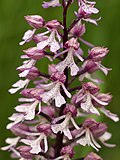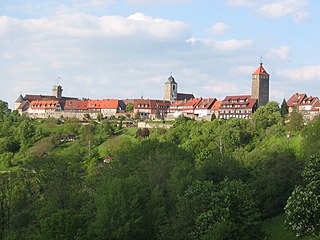
Waldenburg is a hilltop town in south central Germany, eastwards of Heilbronn in the Hohenlohe (district) of Baden-Württemberg. The town is the site of Waldenburg Castle and some hilltop churches. Records first mention Waldenburg in the year 1253, but the town was destroyed in April 1945, at the end of World War II, and it has been rebuilt since.

The Elz is a river in Baden-Württemberg, Germany, a right tributary of the Rhine. It rises in the Black Forest, near the source of the Breg. The Elz flows through Elzach, Waldkirch and Emmendingen before reaching the Rhine near Lahr. Its length is approx. 121 km (75 mi).

The Wildsee is a small lake within an area of bog between Bad Wildbad and Gernsbach, high in the Northern Black Forest mountain range in southwestern Germany. The lake is fed by rain water. It is part of the Kaltenbronn Nature Reserve.
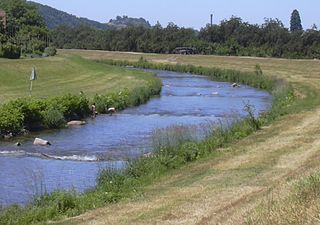
The Rench is a right-hand tributary of the Rhine in the Ortenau. It rises on the southern edge of the Northern Black Forest at Kniebis near Bad Griesbach im Schwarzwald. The source farthest from the mouth is that of the Schöngrundbächle which rises at a height of around 915 m above NN in the parish of Zuflucht near the old youth hostel. After flowing through its steep mountainside klinge it is joined by other streams to form, first, the Old (Alter), then the Wild Rench, which first becomes the Rench below Bad Griesbach. The Rench runs in a prominent southerly arc through the Central Black Forest and crosses the hilly region of Ortenau with its orchards and vineyards before breaking out into the Rhine Plain. After just under 57 km it discharges, together with the Mühlbach, into the Rhine at 314.7 km between Helmlingen (Rheinau) and Lichtenau.
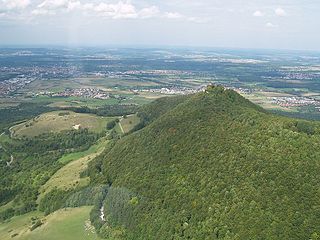
Teckberg is a mountain at Landkreis Esslingen in Baden-Württemberg, Germany, with an elevation of 775 metres.775 m above sea level (NHN) Situated on top is castle Teck.

The Blinde Rot, also called the Adelmannsfelder Rot, is a river in the Ellwangen Hills in the north of the German state of Baden-Württemberg, that rises in the municipality Frankenhardt and discharges into the Kocher in the municipality of Abtsgmünd.

The Wild Gutach is a river in Baden-Württemberg, Germany. It flows into the Elz in Gutach im Breisgau.

Leutra is a small river in Thuringia, Germany. It flows into the Saale in the village Maua, in the southern part of Jena. Another small river also named Leutra flows into the Saale in the centre of Jena, 6 km to the north.

The Nesse is a 54.5-kilometre-long (33.9 mi) tributary of the Hörsel in the southern Thuringia. Strictly speaking, it represents a second, right main branch of the Hörsel, which brings about as much water to join the Hörsel as the Hörsel itself and drains an even larger catchment area.

The Pleß is a mountain, 645.4 m above sea level (NHN), in the county of Schmalkalden-Meiningen in the Salzungen Werra Highland in the German state of Thuringia.

The Jennetal is a valley cut in the Schönberg mountain and also the name of a nature reserve, where it's located.

The Hoher Ochsenkopf is a mountain in the Northern Black Forest in the municipality of Forbach in south Germany. At 1,054.5 m above sea level (NHN) it is the highest point in Forbach and also in the county of Rastatt. The mountain, whose domed summit or kuppe was already a nature reserve lies in the Black Forest National Park which was founded in 2014. Its name recalls its former use as wood pasture.

The Nonnenmattweiher is a lake that has been impounded by an embankment in the Southern Black Forest in Germany. Together with the surrounding area it forms a nature reserve of the same name in the High Black Forest in the state of Baden-Württemberg.

The Glaswaldsee near the spa town of Bad Rippoldsau-Schapbach in the Central Black Forest in Germany lies in a cirque that is sunk into the steep eastern mountainside of the Lettstädter Höhe. It is part of the nature reserve of the same name that was established in 1960.
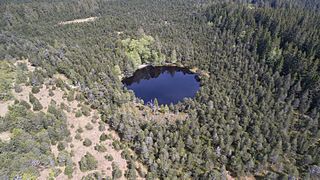
The Blindensee is a raised bog lake on the territory of Schönwald im Schwarzwald in the Black Forest in Germany. It lies within the county of Schwarzwald-Baar-Kreis in the state of Baden-Württemberg. It is only accessible on a board walk and lies with raised bog area that has been designated as a nature reserved near the watershed between the rivers Gutach and Elz.

The Schlüchtsee is a small, artificial lake in the Southern Black Forest near Grafenhausen in the county of Waldshut in Germany, through which the River Schlücht flows.

The Jagdbergtunnel is a 3.074 km tunnel on Bundesautobahn 4, west of the town of Jena, in Germany. Construction began in 2008 and lasted until 2014, when the tunnel opened. The tunnel was built to expand the capacity of the Autobahn, while protecting Leutratal nature reserve, an important site for European orchids. It is one of the ten longest road tunnels in Germany.

The Wernau Quarry Ponds are a Nature Conservation Area established by the Stuttgart Regional Commission on June 5, 1981. They are located within the jurisdiction of Wernau and Wendlingen and the community of Köngen, which are located in the district of Esslingen in the German state of Baden-Württemberg.

The Wernau Clay Pit is a nature conservation area in Wernau, Baden-Würtemberg, Germany established by the Stuttgart Regional Commission on April 15, 1986.

Old Neckar is a nature conservation area designated by decree of the Regional Council Stuttgart on the territory of the municipality Altbach and the town Esslingen in the district of Esslingen in Baden-Württemberg. A 16.0 hectare area had already been placed under protection by decree of December 2, 1985.


